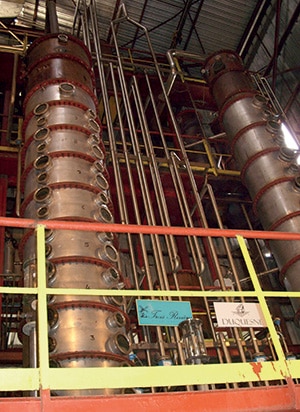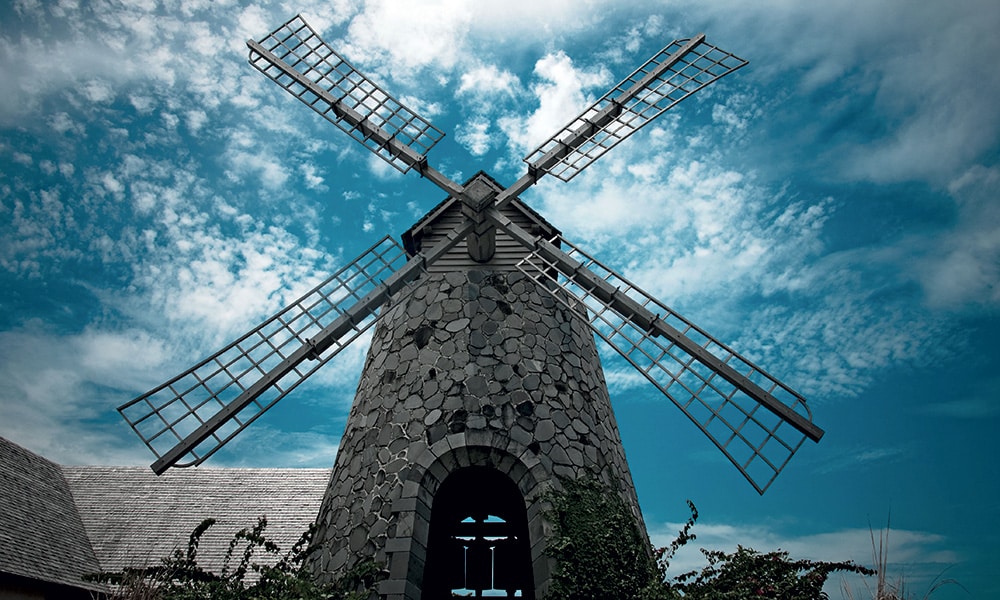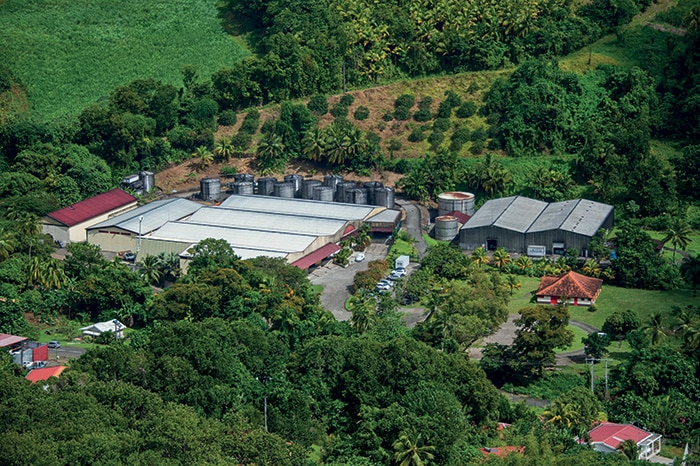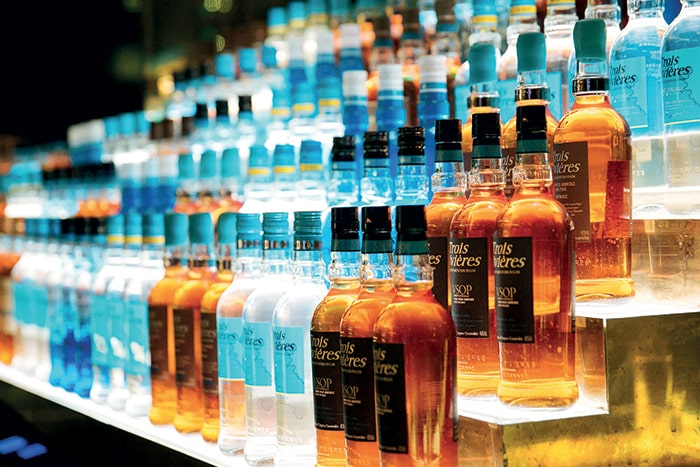Thanks to Rhum, this little Martinique hamlet has become famous around the world – even if its distillery has been out of action since 2004. But the 120 ha plantation still provides its sugarcane juice, and the two distillation columns are still active on the Riviere-Pilote site, less than 5km away.
Its windmill, rather than the three rivers, has become the emblem of the prestigious range. It’s not at all surprising that Trois Rivières became a well-known name amongst rum connoisseurs for its classic vintages, including the 1953, 1964, 1969 and 1977. Most recently, the new 2000 has just eclipsed the acclaimed 1995. Indeed, it’s not at all surprising, considering that the plantation from which they originate is one of the oldest on the island, and is still supplying the distillery 356 years after its creation. It was in 1660 that Nicolas Fouquet, Superintendent of Finances, took on a vast estate of over 2,000 ha in Martinique, on the south coast between Sainte-Luce and le Diamant. He even built a fortified castle, which he would never live in and has since been demolished. In contrast, he ended his days in the dingy dungeon of the Pignerol fortress, after two decades’ imprisonment there. His fall from grace was just as spectacular as his formidable social climb had been, and he was accused – amongst other crimes – of having plotted to become viceroy from his estates in Martinique and Saint-Lucia.

Before Fouquet, it was colonialists who, settling on the south coast of Martinique, created a village named Trois-Rivières at the beginning of the 17th century quite simply because it stands on the meeting point of the river Oman, the river Bois d’Inde and the river Saint-Pierre. It might seem a bit of a struggle to call these three streams, which are barely visible on Google Map, “rivers”, but they named it as best they could with the topographical features they had to work with.
Where there is sugarcane there is also sugar, of course, and the property comprised three different sugar refineries, some vestiges of which remain today. But, it would take several
In 1905, the new owner Amédée Aubéry, who was also an industrialist, modernised the site and most significantly halted sugar production in order to concentrate solely on the distillation of Rhum. In 1940, his son would go even further, deciding to abandon the use of molasses and using instead only fresh sugarcane juice, thereby producing the first Rhums Agricoles in Martinique.
Between Duquesne and La Mauny
After the Second World War, Trois Rivières entered a long period of turbulence where even the brand itself disappeared for two decades, only to return triumphantly to the market thanks to its vintage Rhums which had been carefully set aside… luckily for us.
A new change of owner and of direction took place in 1994, when Trois Rivières was taken over by the BBS group, this time reuniting real Martinicans; on the one hand the Bellonnie brothers, who had owned la Mauny since 1923 and on the other Jean-Pierre Bourdillon, who fought long and hard for the creation of the AOC Martinique designation of origin in 1996. Undoubtedly concerned with making their equipment profitable, the BBS group decided to close the Trois Rivières site in 2003 and to move production to Riviere Pilote, the old site of La Mauny. But the two distillation columns were transferred over, and the Trois Rivières and DuquesneRrhums (which have different production processes) were both produced and stored there according to their own specific requirements.
But that wasn’t the end of the company changing hands. In 2007, BBS was bought out by Quartier Francais, a large sugar refining company based in la Réunion. But, due to the concentration of capital, Quartier Francais was bought out in 2010 by Terreos (previously Beghin-Say), which had nothing to do with the spirits industry, and subsequently sold it on to la Martiniquaise, whose speciality was spirits. However, la Martiniquaise already possessed Dillon, Old Nick and Saint-James, and authorities decided that they could not become owners of over 60% of the rhums produced in the Antilles. They were therefore obliged to sell a part of it. This was to BBS (and therefore Trois Rivières) who in 2012 became owners of the Cyrille Chevrillon group, a family-owned company which, in its own words, “invests in industrial and services companies with great potential in order to transform them into national and international leaders.” Its eclecticism is patently obvious, since its activities include pharmaceuticals (Laboratoires Delagrange), printing (CPI Industries), insurance (Albingia) and even flowers (Interflora). We hope that Trois Rivières can find some stability here, compared with its recent past.
The four ranges of Trois Rivières
From its two distillation columns and its plantation of 120 ha of sugarcane (which are said to supply 80% of its needs), Trois Rivières now produces Rhums Agricoles distributed amongst four categories
The Classics include:
– Cuvée Spéciale Mojito and Long Drink (40%) a blend of three different white Rhums
– Cuvée de l’Océan (42%) comes from sugarcane which is produced with the bottom of its stalks in the water (“pieds dans l’eau”) on a parcel in Anse Travaud in south Martinique
– Rhum Blanc (50%), smooth and aromatic
– Rhum Blanc (55%), full-bodied and well-structured
– Ambré (40%) aged for between 12 and 18 months in oak casks
– Cuvée du Moulin (40%) aged for three years in casks
– Rhum Vieux (40%) with a pale colour
– VSOP Réserve Spéciale (40%)
– Triple Millésime (42%) a blend of three vintage rhums (1998, 2000 and 2007) aged together for 7 years.
The Signatures include:
– Single Cask (43%) produced in single casks and non-chill filtered
– Cask Strength vintages bottled at full proof after being aged in new American oak casks
The Extra-Vieux and Grandes Cuvées include:
– 12 Yr (42%) aged in a bourbon cask
– Millésime 1995 (43%) first aged in bourbon casks and then cognac ones.
– Millésime 2000 (42%) aged in oak casks.
The Rares and Millésimés currently only include one variety, the Millésime 1980 (45%) presented in a Baccarat carafe packaged in a lacquered wooden box. Other equally prestigious vintages should follow in the future.
Finally, for the 355th anniversary of its creation, the plantation has just produced the 355, a limited edition white Rhum at 55%: a much-needed addition!



